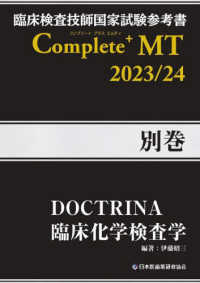Full Description
This book tells a fascinating legal mobilisation story. Analysing EU environmental litigation over the last 30 years, it illustrates how the European environmental movement has patiently attempted and succeeded in expanding access to justice opportunities before the EU Courts.
This is despite the longstanding reluctance of the EU Court of Justice to soften its standing requirements for private applicants bringing cases directly to Luxembourg. This research draws on both doctrinal analysis and qualitative methods of socio-legal inquiry. At its heart are interviews with key stakeholders: environmental lawyers, plaintiffs, and activists, which give an invaluable and innovative perspective on strategic litigation before the EU judiciary.
With the growing emergency posed by the climate crisis and resultant increased litigation, this book makes a significant scholarly contribution to the study of environmental movements, to our conceptualisation of legal mobilisation, and to our understanding of the impact of litigation in European environmental law.
Contents
Introduction
1. Legal Mobilisation as a Theoretical Framework
2. My Research
3. Methodology
3.1. Cases Selection
3.2. Direct Observation and Semi-Structured Interviews
3.3. Other Sources
4. Structure
1. Plaumann as a 'Closure'
1. The Plaumann Test
2. Stein's and Vining's Contribution
3. Rasmussen's Contribution
4. Van Wolferen's Contribution
5. The Greenpeace Case
6. Mobilising Against Plaumann in the 'Pre-Aarhus' Period
6.1. Treating the Environment Differently
6.1.1. Treating Engos Differently
6.2. Effective Judicial Protection
6.3. EU Law Consistency
6.3.1. Consistency with EU Secondary Law
6.3.2. Consistency with the Case Law Of the CJEU
7. AG Jacobs And Plaumann
8. Conclusions
2. Circumventing Plaumann Via National Courts
1. 'Complete', Yet Not Perfect
2. Using AG Jacobs' Opinion
3. Opening Legal Opportunities at National Level
4. Training National Judges and Practitioners
5. Engos and the PRP on Validity
5.1. The Associazione Italia Nostra Case
5.2. The Xylella Case
5.3. The Blaise Case
5.4. The Vereniging Hoekschewaards Landschap Case
5.5. Preliminary Conclusions on Engos and the PRP on Validity
6. Conclusions
3. Shaping the Aarhus Convention
1. The Aarhus Convention
2. Engos and the Aarhus Negotiation
3. The Introduction of the 'Justice' Pillar
4. The EU Adhesion to the Aarhus Convention
4.1. The Aarhus Regulation
5. Mobilising Against Plaumann in the 'Post-Aarhus I' Period
6. The Arguments of the Applicants in Stichting Natuur
6.1. An Act of 'Individual Scope'
6.2. Compliance with International Environmental Law
7. Conclusions
4. Using The Aarhus Convention Against Plaumann
1. The Role Of the ACCC
1.1. Composition and Functions
1.2. The Scrutiny of the Compliance Committee
2. Clientearth as a Legal ENGO
3. ACCC/C/2008/32
4. Mobilising Against Plaumann in the 'Post-Aarhus II - Post Findings' Period
4.1. The Non-Binding Character of the ACCC's Findings
4.2. The Impact of the ACCC's Findings
5. The Impact Of The ACCC's Findings on the EU Decision-Making
5.1. The Commission's Study and Report
6. The Clientearth v. EIB Case
6.1. Comment on the Clientearth v. EIB Case
7. Conclusions
5. The New Aarhus Regulation
1. Shaping the New Aarhus Regulation
2. The New Definition of 'Administrative Act'
2.1. Other Main Amendments
3. Contesting EU Regulatory Acts: Where Do We Go?
3.1. Clientearth v. Commission
4. Conclusions
6. Plaumann and Climate Change Before Non-EU Courts
1. The Global Climate Change Litigation Trend
2. Understanding Strategic Litigation at GPI
3. Framing 'Judicial Comfort'
4. Building Blocks and 'Incrementalism'
4.1. The People v. Arctic Oil Case
5. Preliminary Conclusions on GPI - An 'Obsolete' Court
6. Understanding Strategic Litigation at GLAN
6.1. The Duarte Agostinho Case
6.2. The Court's Judgment in Duarte Agostinho
6.3. Comment on the Duarte Agostinho Case
6.4. The Müllner v. Austria Case
6.5. EU Climate Law and the Bosphorus Presumption
6.6. The Political Impact on the EU of CCL in Strasbourg
7. Conclusions
7. Plaumann and Climate Change Before the CJEU
1. Using Article 263(4) TFEU in CCL
2. Constructing the Carvalho Case
2.1. Lawyers Seeking Plaintiffs
2.2. Litigation and Communication
3. The Carvalho Case Before the EU Judiciary
3.1. Establishing Causation in Carvalho
4. The Aftermath of Carvalho
5. Contesting EU Policy on Biomass Energy
5.1. Constructing the Sabo Case
6. The Sabo Case Before the EU Judiciary
6.1. Which Fundamental Rights?
6.2. Establishing Causation in Sabo
6.3. Standing and Aarhus
6.4. Is Aarhus Enough?
7. The Aftermath of Sabo
8. Conclusions
Conclusions
1. Who?
2. Why?
3. How?
3.1. Turning Defeats into Opportunities
3.2. Combining Legal and Non-Legal Mobilisation Strategies
4. What?
5. Grounds for Future Research
Bibliography








